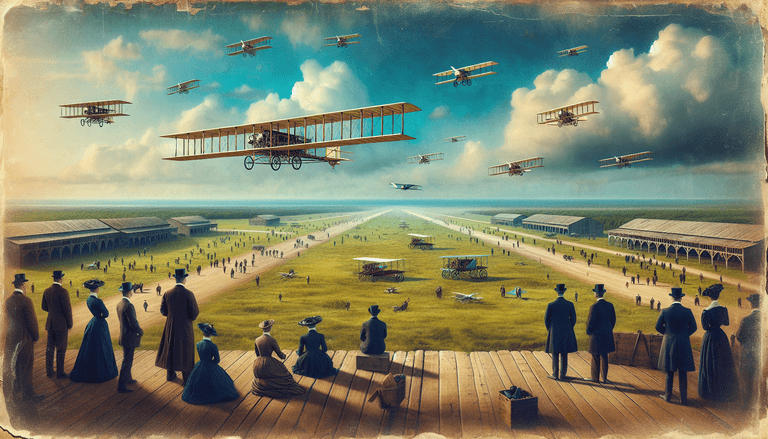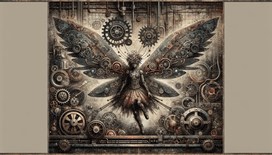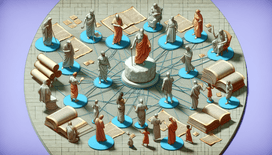Oh, the hallowed halls of history! They echo with tales of ambition, courage, and the occasional technological fail. Picture this: Dayton, Ohio, in the early 20th century, where two enterprising brothers, Orville and Wilbur Wright, are feverishly dreaming up what just might be, at least they hope, a flying machine. Fast forward to today with me, in a delightful romp through time, to imagine what could have happened if those visionary gents had been equipped not with canvas and wood, but with the revolutionary wonders of AI-piloted drones.
The Birth of Flight: A Wright Turn
Our story begins in the modest bicycle shop of the Wright brothers, where the air is thick with the buzz of screwdrivers and the intoxicating smell of ambition (and perhaps slightly under-washed socks). The history books tell us that these ingenious chappies first took to the skies in 1903 with the aptly named Wright Flyer. But hold your horses, or aeroplanes, in this whimsical reimagining, our dashing duo have stumbled upon a curious piece of modern wizardry: AI-piloted drones.
With drones in their toolkits, the Wright brothers could have avoided some of aviation’s more literal crashes. Instead of manual flights over the sandy hills of Kitty Hawk, drones, complete with advanced AI, could have handled test flights, dodged trees, and gracefully avoided an untimely rendezvous with the ground. Orville and Wilbur wouldn’t just be men of flight but veritable conductors of an aerial symphony.
A Lesson in Aerodynamics: Drone From Above
Picture the scene: Orville and Wilbur, enthralled by their newfound AI companions, perhaps they would christen one “Propella Watson”, engage in constant debates not about the mechanics of flight (the drones have that sorted) but rather about movies from Hollywood classics, pondering why exactly the drone seems to prefer Cary Grant to Buster Keaton. Ironically, in this update of history, it’s the drones doing the learning, adjusting to the whims of wind and weather, making calculations faster than a caffeinated mathematician on a sugar rush.
Did you know, dear reader, that AI could outperform any novice in the art of controlling the minutiae of wind resistance and gravitational pull, transforming a risky flight into a mere drone-cular stroll in the park? Alongside brisk debates about tail designs and the advantages of rudimentary ailerons, the Wrights, buoyed by AI assistance, could leap-frog (leap-drone?) years of trial and error.
The Aerial Age Accelerates: From Drones to Domination
As the world stood wide-eyed in awe of this newfangled flight, Orville and Wilbur, their trusty drones by their sides, could have achieved what they originally did but in the span of a short season. No longer was flight the stuff of mythical Icarus but of practical innovation and everyday conversations like, "Are those packages being delivered by air? Fabulous!”
Our dynamic duo could have dashed across the world stage, delivering TED Talks (tentatively titled "Take Flight! Droning On with the Wright Brothers"). Their talks on the synergy between human ingenuity and AI-powered assistance would have had crowds swooning. The aviation industry wouldn't just be born, it would skyrocket.
The Wright Impact: A World on the Wings of Change
Imagine, if you will, a turn-of-the-century world where flights of fancy weren't constrained by the uncertainty of untested planes. With drones taking to the skies, the Wright brothers’ command of the skies would have ignited a global race for flight, peppered with cat emojis thanks to AI-enhanced communication across global communities.
Air travel could well be planned out for mass use decades ahead of schedule. Paris to New York? No problem! London to Tokyo? Why not? With AI-drones leading the way in avionics, no expanse of ocean or mountain would be safe from determined Wright family adventure.
Lifting Off into the Imaginative Future
In this delightful diversion from historical fact, the marriage of pioneering spirit and cutting-edge AI technology brings us a vision of a past that skillfully illustrates the possibilities simmering in our present day. What if the daring dreams of Orville and Wilbur, interlaced with the precision of AI, were unified in a time-defying quest for the sky? Such speculative jaunts remind us that amidst the march of progress, it is often the whimsical ‘what ifs’, those delightful exercises in imagination, that pave the runway to our next flight of inspiration.
So take heed, dear readers, as we skim over the wings of imitation and imagination, the question remains: if we, too, dare to dream and collaborate with wonders of modern tech, what marvellous heights might we reach in the time to come?







